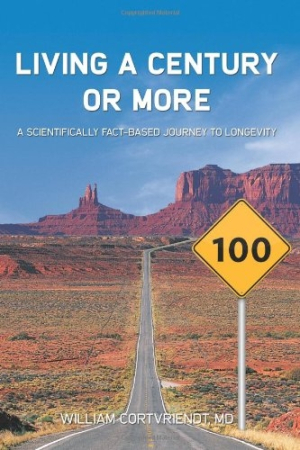Living a Century or More
A Scientifically Fact-Based Journey to Longevity
Accessible, helpful definitions and explanations make these scientific answers to health concerns easy to digest.
Living a Century or More: A Scientifically Fact-Based Journey to Longevity, by William Cortvriendt, explores a dream—living to a healthy old age—that’s being made more possible by modern scientific understanding.
The book begins with a brief look at the concept of aging and then examines research that reveals ten common themes in “blue zones”—regions that have a disproportionately high number of people who are healthy and live to be more than one hundred years old. Chapter by chapter, the volume moves through common themes and factors that influence longevity.
Chapter 1 points out that most access to medical research today is filtered through popular media. This book refreshingly counterbalances the headline-driven miracle remedies that are so prevalent. While media-promoted cures often go through a cycle of hype and disappointment, Cortvriendt applies medical depth to commonsense health solutions, showing how everyday decisions have a meaningful effect on long-term health.
Rather than scientific advances in medications or surgical procedures, Cortvriendt covers topics ranging from medical conditions to lifestyle and consumption choices, including cholesterol, hypertension, dental hygiene, stress, alcohol, and salt. These topics are applicable to almost anyone and present relatively easy, cost-effective ways to lengthen life.
The author’s medical research skills shine. He brings together well-sourced findings from across medical fields. His experience in pharmaceutical research, medical devices, and medical consulting provides wide-ranging but deep insights. His expertise and no-nonsense presentation give the book a thoroughly trustworthy feel. As the subtitle states, the volume is very scientific: there are chemical diagrams of omega-6 and omega-3 acids, complex terms like “relative mortality risk,” MRI images, and graphs on everything from the relationship between exercise and bone density to insulin responses to white and dark chocolate. As a result, the text can be intimidating at first glance.
However, Cortvriendt makes certain that educated but nonscientific readers will understand the information; he explains terms and breaks down information step by step. Occasionally, though, wordy, academic-sounding sentences make comprehension more difficult than necessary. For example, “This study compounded the results from all the various studies that had previously reported on the association of chocolate consumption and the risks of developing cardiovascular disease.”
After twenty-eight brief but meaty chapters, the deluge of possible applications and next steps can feel overwhelming. Cortvriendt anticipates this need in the final chapter, “Putting It All Together.” He highlights a handful of key takeaways in less than ten pages: eliminating toxins, eating well, minimizing stress, and staying physically and mentally active. At the end of the chapter is a summary table that goes through the topics presented in the book and shows whether they have a hazardous or helpful effect on cancer, diabetes, cardiovascular disease, blood pressure, psychiatric disease, overall mortality risk, and other issues. This can actually be a great entry point into the volume, as it suggests topics relevant to various lifestyles and health concerns.
Living a Century or More is for those ready to invest in their health in order to live longer.
Reviewed by
Melissa Wuske
Disclosure: This article is not an endorsement, but a review. The publisher of this book provided free copies of the book and paid a small fee to have their book reviewed by a professional reviewer. Foreword Reviews and Clarion Reviews make no guarantee that the publisher will receive a positive review. Foreword Magazine, Inc. is disclosing this in accordance with the Federal Trade Commission’s 16 CFR, Part 255.

